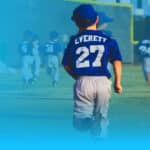Football Playbooks: The Ultimate Guide for Coaches
Reading Time: 12 minutes
Reading Time: 12 minutes
Football playbooks are one of the most important tools for coaches and teams who want to win more games and improve their performance.
With the right playbook, you can organize your plays, clarify player roles, and strengthen your team on offense and defense.
Whether you’re new to coaching or want a fresh perspective, learning to use a playbook well can really change your results on the field.
In this article, you’ll find out what makes a great football playbook and how to build or tweak one for your team.
You’ll also pick up tips and strategies that top coaches rely on to keep their teams ready and confident.
The Basics of Football Playbooks
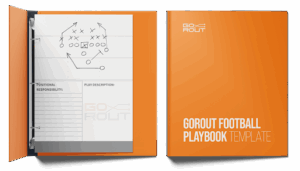
A football playbook is a collection of football plays that guides your team during games. Each play lays out how players should move and work together to gain yards and score points.
Here’s what you’ll find in a basic playbook:
- Formations: Set positions for all players
- Plays: Step-by-step strategy to move the ball down the field through specific actions for each player
- Terminology: Key words used by your team
When you flip through a playbook, you’ll see diagrams and notes for different sets. A set means how your players line up before the play starts, like the shotgun or I-formation.
Some plays focus on running the ball, while others use passes to pick up yardage fast. Coaches use playbooks to mix things up and keep defenses guessing.
Good playbooks mix simple and complex plays based on players’ age and experience. The simple ones help players learn, while the harder plays introduce advanced strategies as your team levels up.
Check out this free football playbook template to learn more.
Key Components of Winning Football Playbooks
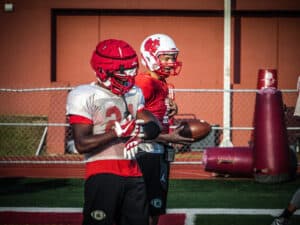
Well-built football playbooks balance simple ideas with detailed instructions. Here’s what to focus on.
Formations and schemes
Your playbook should offer a mix of formations—like I-formation, spread, or Wing-T. Diverse formations let you attack in different styles and help players understand their roles.
Formations need to stay consistent so everyone knows where to line up on the field.
Direction and assignment clarity
Plays should spell out who blocks which defender, where the ball goes, and how the play should look. Use simple words or images so every position knows their job.
Visual diagrams and teaching tools
Add clear diagrams for each play. Use lines and arrows to show routes, blocks, and runs. Visuals really help players learn faster.
Risk, constraint, and counter plays
Mix in both safe and high-risk plays. Add constraint plays—like screens or draws—to keep defenses open. Always have counters ready since defenses will adjust.
Versatility and flexibility
Design plays you can change at the line based on what the defense shows. Use football play-calling systems, audibles, and hot routes that let you make quick changes and decisions on the field.
Consistent terminology
Keep your play call language and symbols simple. Stick to the same names and words so there’s no confusion in the huddle or at football practice.
Step-by-step progression
Lay out plays so players start with basics and add new elements as they get comfortable. This way, teaching stays manageable, and your team builds confidence.
Setting a clear order for player movements ensures coordinated actions and prevents collisions during complex plays.
Creating Football Playbooks for Different Levels

Designing a playbook depends on your team’s age, skill, and the type of game you’re playing. Whether you coach youth, high school, college, NFL, or flag football, each level needs its approach.
Youth football playbook considerations
Youth playbooks should stay simple and easy to follow. The main goal is to teach kids basic positions, rules, and movement.
Skip the complicated plays and stick with basics like I-formation or Single Wing. Use clear diagrams and short, simple instructions. Kids remember plays with fun names and visuals.
Stick to just a few running and passing plays so everyone can actually master them. Focus on teamwork, lining up correctly, and safe blocking and tackling. Fundamentals matter way more than trick plays here.
Short practices and lots of repetition help kids get comfortable. Above all, keep things fun and focus on learning the game.
High school offensive playbook strategies
High school teams can handle more variety and structure. You’ll use more complex sets, like a shotgun, spread, and pro formations.
Script your football practice so athletes can repeat plays, develop timing, and build a strong offense. If you need help organizing, look into these practice script ideas.
Add situational plays—like third-down or red-zone packages—to prepare for different moments. Get your players involved by explaining why each play works.
Use film study and walkthroughs so everyone gets comfortable with new strategies. Mix in run-pass options (RPOs), screens, and simple audibles. Keep the language and naming system clear, and don’t overload less experienced players.
College football playbook complexity
College playbooks are much deeper and more advanced. Most teams have dozens of formations and hundreds of plays with all kinds of variations.
Expect motion, shifts, option routes, and checks at the line. Players at this level watch films, break down opponents, and adjust their plays before and during games.
Your playbook needs to be organized according to the situation: down-and-distance, red zone, special teams, etc.
Install play packages with built-in choices for quarterbacks and receivers. Use detailed diagrams, position-specific notes, and many meetings to teach schemes.
At this level, timing, technique, and adaptability really set teams apart.
NFL playbook sophistication and specialization
NFL playbooks are extremely advanced and specific. Every play is tailored to player strengths, opponent weaknesses, and any game situation. The language is coded and often unique to each team.
Each position group has its own section with precise assignments. Binders or tablets are packed with play diagrams, adjustments, and situational calls. Players memorize hundreds of plays, motions, and defensive keys.
The NFL leans on specialized roles—like third-down backs or nickel corners—and deep playbooks, allowing for complex game plans. It’s all about precise execution, fast decisions, and breaking down every detail with film study and scouting reports.
Flag football playbook basics
Flag football playbooks should be simple, visual, and flexible. Since there’s no tackling, focus on route running, spacing, and quick passes. Plays usually use fewer players (5-on-5 or 7-on-7) to emphasize movement.
Use bold, clear diagrams for receivers and running backs. Try naming plays with colors or numbers, which makes them easy to remember. Stick to a handful of core plays—slants, deep routes, and basic run-pass options.
Teach screens, misdirection, and other tactics to keep defenses on their toes. The playbook should encourage teamwork and field awareness, not just individual skill upgrades.
Offensive Football Playbooks

Building a solid offensive playbook means knowing your team’s strengths, planning smart plays for every situation, and balancing running and passing.
The right offensive strategies can turn a stalled drive into a touchdown.
Popular offensive formations and their advantages
The best offenses usually stick to a few core formations that play to their players’ strengths.
Sets like the I-formation build a tough running game by lining up the fullback and running back behind the quarterback. It helps block defenders and opens up running lanes.
For passing, spread formations like trips—three receivers on one side—help your quarterback spot mismatches and passing windows. With an open set, you can go deep with a speedy receiver or mix in quick throws to the slot.
Stack formations—where receivers line up behind each other—can confuse defenders and create space. Learning when to use these formations, as explained in our guide for dynamic offensive plays, can boost your running and passing games.
Run vs. pass play balance
Keeping things balanced makes it harder for defenses to guess what’s coming and helps your quarterback find open receivers. Use the running game early on to set up your passing attack. If you run the ball efficiently, defenses will crowd the line, opening up deep passes on a go or post rout.
Quick passing plays like screens let your quarterback connect with a receiver in the flat or toss to a running back for easy yards. Mix in draws and running plays so your offense stays unpredictable. Try these running back drills for speed and ball control.
When your offense can switch smoothly between runs and passes, you keep defenses guessing and your quarterback protected.
How to develop a signature offensive style
If you want your team to stand out, build around what your players do best. Got a mobile quarterback? Draw up plays that let him escape the pocket and find open receivers on corner routes. Have a quick running back? Use tosses, draws, and zone runs to get him into open space.
Pick a handful of base formations—like trips, stack, or open sets—and practice them until your team feels comfortable against any defense.
Add motion before the snap to keep the defense guessing who will get the ball. Set up plays that work off each other. Call consecutive run plays, then fake a big run to pull defenders in and hit them with play action.
Lean into your team’s strengths and tweak plays to fit your roster, and your offensive style will be a headache for any defense.
Red zone strategies that convert
Inside the red zone, space gets limited. You’ll have a tough time scoring if your offense is too predictable.
Try bunch and stack formations to create traffic and confuse defenders. These looks help your receivers break free, even when everything feels cramped.
Short, quick routes—think slants or flats—are your friends here. Defenders can’t afford to leave their spots, so these plays often slip through.
Mix in passing plays designed for tight areas, but don’t be afraid to run the ball. Quick screens, a fade to your tallest receiver, or a fast running play behind the center can all work near the goal line.
Good red zone offenses get creative. A well-timed screen pass can grab those last few yards when the middle of the field is too crowded.
Give your quarterback and offensive line multiple options. That way, they can react to whatever the defense throws at them.
Defensive Football Playbooks
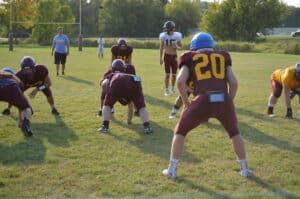
A solid defensive playbook puts your best defenders in the right spots to stop the ball. Knowing how formations, blitzes, and coverages blend gives your defense a real edge.
Base defensive formations
Base defensive formations build the foundation of every playbook. The classics are 4-3 and 3-4.
The 4-3 lines up four linemen and three linebackers—great for stopping the run. The 3-4 swaps in an extra linebacker for more blitz and coverage options.
Pick your base by looking at your defenders’ strengths. Is your roster filled with fast corners and linebackers? You can run more aggressive sets.
Adjusting your base formation helps you cover short passes or defend the deep ball more easily. Learn how defensive schemes create matchups, and you’ll pick the right look for your team.
Blitz packages and when to use them
Blitz packages attack the offense and chase down the quarterback. Send linebackers, safeties, or even corners to pressure the offense and force mistakes.
Timing matters. If the offensive line is weak in the middle, call a middle blitz and try to get a stop or a sack. Edge blitzes work if the offense likes to run or pass outside.
Mix up your blitzes to keep the offense guessing. Use them on third-and-long or when you need to force a quick throw. Just remember, blitzing means less help in pass coverage, so make sure your defenders know how to fill the gaps left behind.
Coverage schemes that compliment your defensive front
Coverage schemes and your defensive front go hand in hand. Zone coverage means defenders watch an area, while man-to-man means they stick to a specific offensive player.
Pairing these coverages with your front creates a strong defense. For example, running zone behind a blitz gives heads-up support if the offense throws a quick pass. Man-to-man coverage can pair well with standard fronts if your corners are quick and skilled.
Adjust your coverage based on what the offense does best. If they throw deep, use a two-deep zone. Facing a team that loves short routes? Go tighter with man coverage.
Situational defensive calls
Situational calls let you adapt to every down and distance. On third-and-short, bring more defenders to the line to stop a run. On third-and-long, drop more defenders into coverage.
Two-minute drills and red zone stands need extra attention—cover the middle field tightly and protect corners from quick passes or fade routes.
Communication is everything. Teach defenders to watch for offensive signals and switch coverage when needed. Your defense can deliver when it counts most by preparing for these moments.
Learning how offenses try to communicate or steal signs can give you a real advantage in high-pressure situations.
Counter strategies for common offensive schemes
Countering common offenses takes some planning. Against spread teams, bring in more defensive backs to cover extra receivers and keep the ball out of the middle. For power running teams, stack the box with linemen and linebackers and work on tackling drills.
When you see option offenses, discipline is everything. Defenders need to stay alert and trust their teammates to handle their zones.
Switch between zone and man coverage, and mix in blitzes to keep the offense off-balance. Drills for your defensive line and linebackers help them learn to react fast.
From Paper to Digital: Modern Playbook Solutions
Coaches used to rely on paper, binders, and markers for playbooks. They used PowerPoint to design plays, sometimes adding stills from actual game films. It helped tie their teaching to real game situations.
Now, tech gives you flexible, advanced tools for creating and managing every play.
Dedicated diagramming tools let you draw, update, and organize plays fast. You can save, download, and share everything with just a click.
Some software lets you drop in video clips, which brings your playbook to life and makes instructions much clearer.
Modern playbooks work on smartphones and tablets, so your team can pull up plays anywhere. It makes it easy to view, study, or update plays on the go.
Many digital playbook apps now track play performance with built-in analytics. It’s pretty handy for tweaking your playbook as the season goes on.
Football Playbook Implementation and Teaching Methods
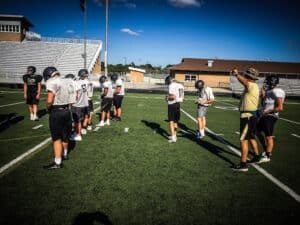
Teaching your playbook starts with clear communication. Use simple words and walk through each play step by step.
Most coaches start with slow walk-throughs before speeding things up. Visual aids like diagrams help players lock in.
Break up complex plays in short group sessions. Always explain the “how” and “why” behind each one.
Practice is where things click. Mix in agility drills to boost speed and reaction—quick thinking matters when you’re running plays.
Regular scrimmages let players practice decisions in game-like situations. Testing understanding is a must.
Ask players to draw plays from memory or walk through them as a team. Quizzes or mock-downs reveal who’s got their assignments down.
As the season rolls on, add more advanced concepts. Start basic, then layer in new plays as your team gets comfortable.
Keep practice varied to fit your team’s needs. Reinforce tackling with focused tackling drills and tie them back to plays from your playbook.
Building a smart practice plan makes a huge difference. Set aside time for review, repetition, and feedback so your players understand and execute every part of your playbook.
Football Playbook Game Day Execution
When the game begins, your playbook becomes your main tool on the field. Turning it into quick call sheets is a lifesaver for making fast decisions.
On the sideline, coach-to-player communication is key. Radios, hand signals, or tablets help coaches and players share information and stay in sync.
You can use advanced in-game technology for real-time play calling and adjustments. Digital apps and tablets let you change your plays and share new information in seconds. It means you can respond to the other team’s moves as the game goes on.
Routines help your team stay focused and calm, even when the pressure’s on. When everyone knows their role, you’ll see smoother execution and better adjustments.
Plan your sideline setup and use the right tools; you’ll be ready for whatever comes up during the season.
GoRout Scout: Revolutionizing Football Practices
GoRout Scout is an advanced sports coaching technology for football practices. It includes web and mobile apps for coaches and wearable practice devices for players.

As a coach, you can create playbooks via the web app that works with any play drawing software. Then, you can send secure and encrypted play calls straight to each player or group using the on-field practice app.

It’s a huge help when you want to run more drills or speed up walkthroughs at practice. You spend less time organizing and more time actually coaching.

Players see play cards and instructions immediately, keeping everyone on the same page. They wear a small device on their wrist that shows play info in real-time—no cards or huddles needed, just quick, clear calls.
Switching between drills like 7v7 or special teams gets way easier. Even new players pick up playbooks faster with visual cues right before them—almost like flashcards on the field.
GoRout Scout runs on a reliable cellular-based system, so you don’t need WiFi in your field. It works in rain, heat, or sun, and the screen stays readable in any condition thanks to the light and dark mode. It also comes with a 100% warranty against breakage.
Top ways teams use GoRout Scout:
- Run more plays with scout teams
- Walkthroughs
- 7v7
- Special teams (KO, KOR, P, PR)
- Preparing against up-tempo teams
- Reducing install times for new players
The setup is simple—just drag and drop your play cards into the system and start sending play calls. There is no syncing, routing or pairing. Everything works straight out of the box.
Ready to upgrade your football practice?
Conclusion About Football Playbooks
Football playbooks help you organize your team, teach plays, and make sure everyone knows their role.
When players get the playbook, everything runs smoother on both offense and defense. That boost in teamwork and confidence? You can feel it on the field.
A good playbook uses clear language and diagrams. Simple instructions work best—nobody wants to flip through a novel during practice. Staying flexible and updating your playbook keeps your team ready for anything.
Here are some key tips:
- Know your players’ strengths
- Use simple play diagrams
- Practice plays often
- Adapt to different opponents
If you want to make play-calling less of a headache, consider GoRout Scout. Based on numerous testimonials and case studies, this digital communication system will help you share real-time plays with your team and boost your results on the field.


